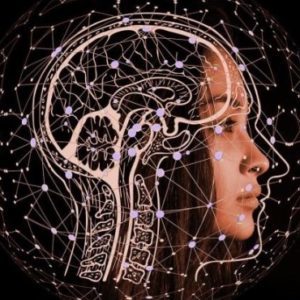
The term ‘Adverse Childhood Experience’ or simply ‘ACEs’ refers to a range of negative situations a child may face or witness throughout their childhood and before the age of 18.
ACEs can impact kids’ health and well-being, and they can have long-term effects on adults’ health and wellness. They can even have consequences that affect entire families, communities, and our whole society.
The term ‘ACE’ comes from a study that was conducted in the United States in the 1980s that found a significant link between a person’s exposure to ACEs and their physical and mental health throughout their lives.
These experiences include all types of abuse and neglect as well as parental mental illness, substance use, divorce, incarceration, and domestic violence.
The study found that the more ACEs a person has experienced, the greater the risk of them experiencing a range of issues such as chronic disease, depression, and anxiety, as well as poor academic achievement and substance abuse later in life.
What Are The Common ACEs?
The ACE test is broken down into 10 out of approximately 300 different traumas because they were the most common in the group.
The most common 10 ACEs recorded are divided into 3 groups and are listed below:

Additional ACEs can also have a significant impact on children and families. They include:
- loss of a parent, caregiver, sibling or grandparent due to death, or separation due to deportation or immigration
- living out-of-home, such as foster care or homeless
- experiencing harassment, bullying, racism, prejudice or other forms of discrimination
- having a serious medical procedure or life-threatening illness
- community violence
- neglect or abuse from someone other than a parent
- growing up with a parent or other household member with a serious physical illness
- being in a car accident,
- being born prematurely
- difficult relationships with your parent … and many other types of adversity we frequently dismiss because they are so common
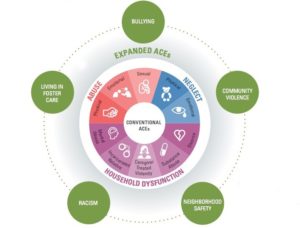
Experiencing many ACEs without supportive adults can lead to toxic stress. This excessive activation of the stress-response system can lead to long-lasting wear-and-tear on the body and brain.
What Is Your ACE Score?
The survey consists of ten questions. Each “yes” answer is assigned one point. At the end of the questionnaire, the points are totalled for a score out of ten, which is known as the ACE score.
Take the test now to see what your ACE score is. Each “YES” answer counts as 1 ACE.
Prior to your 18th birthday:
- Did a parent or other adult in the household often or very often… Swear at you, insult you, put you down, or humiliate you? or Act in a way that made you afraid that you might be physically hurt?
- Did a parent or other adult in the household often or very often… Push, grab, slap, or throw something at you? or Ever hit you so hard that you had marks or were injured?
- Did an adult or person at least 5 years older than you ever… Touch or fondle you or have you touch their body in a sexual way? or Attempt or actually have oral, anal, or vaginal intercourse with you?
- Did you often or very often feel that … No one in your family loved you or thought you were important or special? or Your family didn’t look out for each other, feel close to each other, or support each other?
- Did you often or very often feel that … You didn’t have enough to eat, had to wear dirty clothes, and had no one to protect you? or Your parents were too drunk or high to take care of you or take you to the doctor if you needed it?
- Were your parents ever separated or divorced?
- Was your mother or stepmother:
Often or very often pushed, grabbed, slapped, or had something thrown at her? or Sometimes, often, or very often kicked, bitten, hit with a fist, or hit with something hard? or Ever repeatedly hit over at least a few minutes or threatened with a gun or knife? - Did you live with anyone who was a problem drinker or alcoholic, or who used street drugs?
- Was a household member depressed or mentally ill, or did a household member attempt suicide?
- Did a household member go to prison?
Now add up your “Yes” answers: This is your ACE Score _________

Risk For Chronic Illness Is Affected By Our ACE Scores
As the number of ACEs increases, so does the risk for these outcomes. The presence of ACEs does not mean that a child will experience poor outcomes. However, children’s positive experiences or protective factors can prevent children from experiencing adversity and can protect against many of the negative health and life outcomes even after adversity has occurred.
Studies have found that ACEs increase the risk for autoimmune diseases such as multiple sclerosis, type 1 diabetes, rheumatoid arthritis, lupus, and more; type 2 diabetes, obesity, asthma, chronic obstructive lung disease, heart disease as well as cancer and other chronic physical and mental illnesses.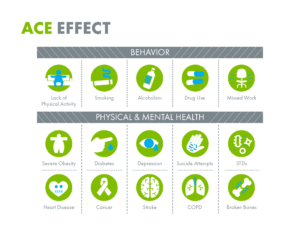
The risk of developing the 80 or more types of autoimmune diseases increases as ACE scores rise.
For every increase in the ACE score of 1 point, the risk for developing an autoimmune disease such as type 1 diabetes, lupus, rheumatoid arthritis, Hashimoto’s thyroiditis, and many others goes up by 20%.
An ACE score of only 2 – which can happen if your parents divorced and one of your parents had to cope with a common mental illness such as anxiety or depression – increases the chances of being hospitalized for autoimmune disease by 70 to 80%.
Individuals who had faced 4 or more categories of ACEs were twice as likely to be diagnosed with cancer as individuals who hadn’t experienced childhood adversity.
The risk of chronic illness is especially high when a person has experienced 4 or more ACEs.
With a score of 4 or more, the risk for diabetes goes up 1.6 fold, doubles for cancer and heart disease, quadruples for chronic lung disease and depression, and rises 7 times for alcoholism and12 times for suicide.
An ACE score greater than or equal to 6 shortened an individual’s lifespan by almost 20 years.
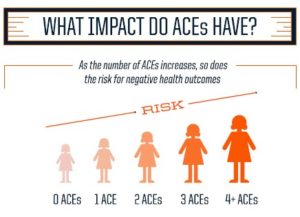
The most important thing for you to remember is that your ACE score is meant to be a guideline. If you experienced other types of toxic stress, whether over months or even years, then those would most likely increase your risk of health consequences.
Remember this also: ACE scores don’t tally the positive experiences in early life that can help build resilience and protect a child from the effects of trauma. Having a family who loves you, a teacher who understands and believes in you, or even a trusted friend you can confide in may mitigate the long-term effects of early trauma.
Today, neuroscientists are looking into the brain-body connection and breaking down exactly how the stresses we face when we’re young catches up with us when we’re adults, altering our bodies, our cells, and even our DNA.
Symptoms Are Not Just Psychological
In chronic disease states, lowered cortisol is not due to any adrenal or pituitary insufficiency. It comes from a body caught in a state of survival.
Changes in cortisol reflect an early-life adaptation to increase the persistence of active cortisol in the liver (to maximize fuel output) and kidney (to increase salt retention) without elevation of circulating levels, thus avoiding their deleterious effects on brain and muscle
As with cortisol, changes in blood sugar, insulin levels, blood pressure, heart rate, and other physiological functions can get stuck in high or low patterns. This is part of how our body’s states of survival can lead to symptoms and disease.
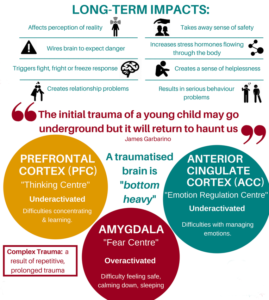
Trauma affects both physical and emotional health because it alters the nervous system, the immune system, the cell danger response, gene function, and beyond.
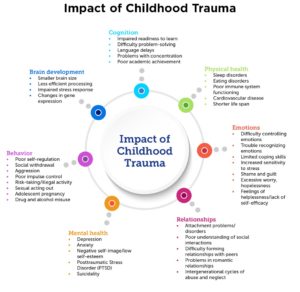
Understanding these mechanisms and the science of trauma offers hope for people living with chronic illness. This is because healing the effects of trauma is possible, even if the events happened far in the past. Addressing the effects of trauma also helps heal symptoms of chronic disease.
Absence of Nurturing – A Larger Impact Than The Presence Of ACEs
A 2019 study in Utah, USA found that the absence of positive, nurturing, protective experiences may have a greater impact on health and risk for chronic conditions than the presence of abuse and other ACEs.
This finding has been a shock to many.
It’s a game-changer for others who have known, deep down, that something wasn’t right even if it all “seemed” normal when they were kids. Their difficulties maintaining healthy relationships, liking other humans or trusting people have just not seemed normal. Their challenges in feeling worthy. Their bodies don’t respond to treatments that seem to work for others.

Anti-ACEs / Counter-ACEs Increase Resilience
The research found that positive experiences are protective. So protective, in fact, that they called them “anti-ACEs” or “counter-ACEs” because they reduce the effects of adversity in significant ways.
They found that the kinds of experiences that reduce the risk for chronic conditions, painful beliefs, and difficult emotions later in life can seem small. They can appear inconsequential given their huge influence. And yet the little things turn out to make a big difference in buffering children from the effects of adversity.

The kinds of things that create, support, and increase resilience in children include:
- Having good friends & neighbours
- Beliefs that provide comfort
- Liking school
- Teachers who care
- A caregiver who you feel safe with
- Opportunities to have fun
- Feeling comfortable with yourself
- A predictable home routine like regular meals and bedtimes
What anti-ACEs also mean is that support for parents can also help, especially if parents have their own challenges and histories of trauma. Finding ways to create predictable home routines, for example, can make a big difference.
What’s Your Resilience Score?
This questionnaire was developed by the early childhood service providers, pediatricians, psychologists, and health advocates in Maine, USA. They came up with 14 statements with a scoring system that was modeled after the ACE study questions.
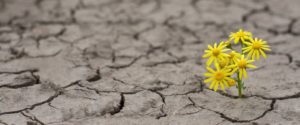
Its purpose is limited to parenting education. It was not developed for research. The resilience questions are only meant to prompt reflection and conversation on experiences that may help protect most people (about three out of four) with four or more ACEs from developing negative outcomes. A secure early childhood is helpful, but not necessary. A higher number of positive experiences is not necessarily more protective, but it is indeed helpful in limiting the overall effect of ACEs long-term.
Take The Resilience Questionnaire
Please circle the most accurate answer under each statement:
- I believe that my mother loved me when I was little.
Definitely true Probably true Not sure Probably Not True Definitely Not True
- I believe that my father loved me when I was little.
Definitely true Probably true Not sure Probably Not True Definitely Not True
- When I was little, other people helped my mother and father take care of me and they seemed to love me.
Definitely true Probably true Not sure Probably Not True Definitely Not True
- I’ve heard that when I was an infant someone in my family enjoyed playing with me, and I enjoyed it, too.
Definitely true Probably true Not sure Probably Not True Definitely Not True
- When I was a child, there were relatives in my family who made me feel better if I was sad or worried.
Definitely true Probably true Not sure Probably Not True Definitely Not True
- When I was a child, neighbors or my friends’ parents seemed to like me.
Definitely true Probably true Not sure Probably Not True Definitely Not True
- When I was a child, teachers, coaches, youth leaders, or ministers were there to help me.
Definitely true Probably true Not sure Probably Not True Definitely Not True
- Someone in my family cared about how I was doing in school.
Definitely true Probably true Not sure Probably Not True Definitely Not True
- My family, neighbours, and friends talked often about making our lives better.
Definitely true Probably true Not sure Probably Not True Definitely Not True
- We had rules in our house and were expected to keep them.
Definitely true Probably true Not sure Probably Not True Definitely Not True
- When I felt really bad, I could almost always find someone I trusted to talk to.
Definitely true Probably true Not sure Probably Not True Definitely Not True
- As a youth, people noticed that I was capable and could get things done.
Definitely true Probably true Not sure Probably Not True Definitely Not True
- I was independent and a go-getter.
Definitely true Probably true Not sure Probably Not True Definitely Not True
- I believed that life is what you make it.
Definitely true Probably true Not sure Probably Not True Definitely Not True
How many of these 14 protective factors did I have as a child and youth? (How many of the 14 were circled “Definitely True” or “Probably True”?) _______
Of these circled, how many are still true for me today? _______
Reducing The Effect Of ACEs & Toxic Stress

No-one who has experienced significant adversity (or many ACEs) is irreparably damaged, though we need to acknowledge trauma’s ill effects on their lives.
The good news is that, just as our scientific understanding of how adversity affects the developing brain is growing, so is our scientific insight into how we can help out the adults with a damaged childhood, and how small steps can be taken to heal the body and the brain. Just as physical wounds, broken bones, and bruises heal, just as we can regain our muscle tone, and just as we can gain or lose weight, we can recover function in under-connected areas of the brain.
No child is magically resilient or invulnerable to ACEs, just as no individual child is automatically doomed in the face of ACEs. These protective factors can include a person’s own biological and developmental characteristics. But protective factors can also include characteristics of the family, community, and systems that mitigate the negative impacts of ACEs. Protective factors help explain how some people who have sustained a great deal of adversity as children have fared relatively well in adulthood.
The presence of protective factors, particularly safe, stable, and nurturing relationships, can often mitigate the consequences of ACEs. Individuals, families, and communities can all influence the development of many protective factors throughout a child’s life that can impact his or her development.
For those who have experienced ACEs, there is a range of possible responses that can help with building resilience, such as:
- therapeutic sessions with a mental health professional
- meditation
- physical exercise
- spending time in nature
- embrace change
- don’t dwell on negative thinking
- create goals
- be optimistic
- have a sense of humour
- develop strong personal relationships
- take good care of yourself
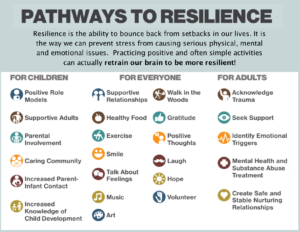
By reducing families’ sources of stress, providing children and adults with responsive relationships, and strengthening the core life skills we all need to adapt and thrive, we can prevent and counteract lasting harm.

Fortunately, brains and lives are somewhat plastic. The appropriate integration of resilience factors born out of ACE concepts – such as asking for help, developing trusting relationships, forming a positive attitude, listening to feelings – can help people improve lives.
In summary, even the negative consequences of toxic stress from ACEs can be buffered with the support of caring, competent adults, and appropriate intervention and support.
We as a community need to be ensuring that the kids within it are getting whatever form of treatment they need to not follow the data trends. And now that we know that ACEs have a real, lifelong impact, it is time to start implementing the screenings and programs necessary to help those affected.
**If you’ve got this far – thank you for reading and I look forward to bringing you more information in the future.
Now, enjoy some much needed inspirational music…
